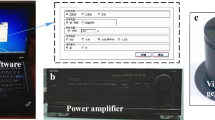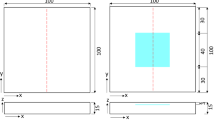Abstract
Laser ultrasonic techniques are used to examine the propagation of ultrasonic waves in concrete. This optical methodology provides a repeatable, broad band generation source and an absolute detection system that does not interfere with the process being monitored. The presence of aggregate, in addition to voids and flaws, can cause wave scattering in concrete. Fast Fourier Transform techniques are used to determine the effect of aggregate size and propagation distance on the frequency content of both surface and body waves. This paper examines the scattering of ultrasonic waves in undamaged concrete and establishes the fundamentals for the application of laser ultrasonics for the material characterization and nondestructive evaluation of concrete.
Similar content being viewed by others
References
H. S. Lew, ed., Nondestructive Testing, ACI SP-112 (American Concrete Institute, Detroit, MI, 1988).
V. M. Maholtra and N. J. Carino, eds., CRC Handbook on NDT of Concrete, (CRC Press, 1991).
S. Popovics, J. L. Rose, and J. S. Popovics, The behavior of ultrasonic pulses in concrete, Cement Concrete Res. 20: 259–270 (1990).
P. A. Gaydecki F. M. Burdekin, W. Damaj, D. G. Johns, and P. A. Payne. The propagation and attenuation of medium-frequency ultrasonic waves in concrete: A signal analytical approach. Measure. Sci. Technol. 3(1):126–134 (1992).
Y. H. Kim, S. Lee, and H. C. Kim, Attenuation and dispersion of elastic waves in multi-phase-media, J. Phys. D: Appl. Phys. 24(10):1722–1728 (1991).
C. G. Tasker, J. M. Milne, and R. L. Smith, Recent work at the national NDT centre on concrete inspection, Brit. J. NDT 32(7): 355–359 (1990).
M. Sansalone, and N. J. Carino, Detecting delaminations in concrete slabs with and without overlays using the impact-echo method, ACI Mater. J. 86:175–184 (1989).
Y. Lin, and M. Sansalone, Detecting flaws in concrete beams and columns using the impact-echo method, ACI Mater. J. 89:394–405 (1992).
C.B. Scruby, Some applications of laser ultrasound, Ultrasonics, 27:195–209 (1989).
D. A. Bruttomesso, L. J. Jacobs, and R. D. Costley, Development of an interferometer for acoustic emission testing. J. Engin. Mech. 119(11):2303–2316 (1993).
P. Delaye, A. Blouin, D. Drolet, and J.-P. Monchalin, Heterodyne detection of ultrasound from rough surfaces using a double phase conjugate mirror, Appl. Phys. Lett. 67(22):3251–3253 (1995).
R. J. Higgins, Digital Signal Processing in VLSI (Prentice Hall, NJ, 1990).
J. D. Achenbach, Wave Propagation in Elastic Solids, (North-Holland, Amsterdam, 1973), pp. 26–29.
E. P. Papadakis, Scattering in polycrystalline media, in Methods of Experimental Physics, Vol. 19, P. D. Edmonds, ed. (Academic Press, 1981).
Author information
Authors and Affiliations
Rights and permissions
About this article
Cite this article
Jacobs, L.J., Whitcomb, R.W. Laser generation and detection of ultrasound in concrete. J Nondestruct Eval 16, 57–65 (1997). https://doi.org/10.1007/BF02683878
Received:
Revised:
Issue Date:
DOI: https://doi.org/10.1007/BF02683878




